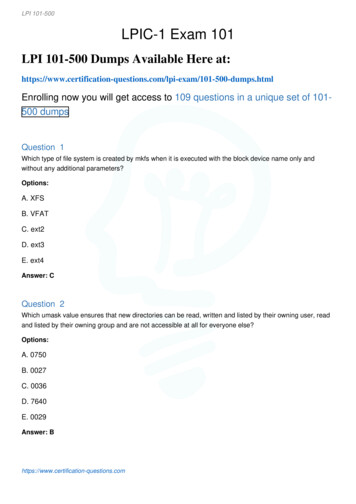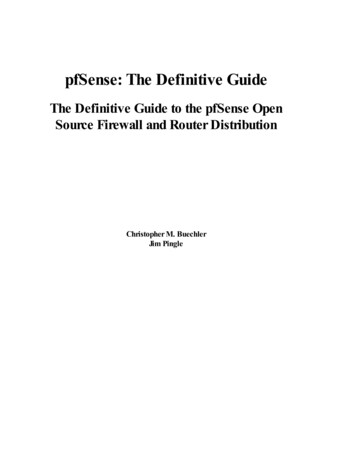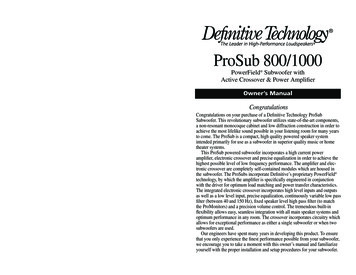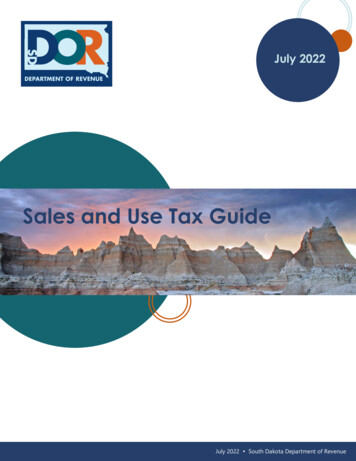
Transcription
THE DEFINITIVEGUIDE TO SALESAND USE TAXA Sales and Use Tax Compliance Primerp. 1/28 The Definitive Guide to Sales and Use Tax. Avalara 2013
TABLE OF CONTENTSINTRODUCTION.3The Sales andUse Tax Landscape. 4Sales and Use TaxComplexities. 9Complying with Salesand Use Tax.14Sales Tax Practices by State.18Alabama. 18Alaska. 18Arkansas. 18Arizona. 18California. 18Colorado. 18Connecticut. 19District of Columbia. 19Florida. 19Georgia. 19Hawaii. 19Idaho. 19Illinois. 19Indiana. 20Iowa. 20Kansas. 20Kentucky. 20Louisiana. 20Maine. 20Maryland. 20Massachusetts. 20Michigan. 20Minnesota. 21Mississippi. 21Missouri. 21Nebraska. 21Nevada. 21New Mexico . 21p. 2/28 The Definitive Guide to Sales and Use Tax. Avalara 2013New Jersey. 21New York. 21North Carolina.22North Dakota.22Ohio.22Oklahoma.22Pennsylvania.22Rhode Island.22South Carolina.22South ington.23Wisconsin.23Virginia. 24West Virginia. 24Glossary.25ADDITIONAL RESOURCES. 28
INTRODUCTIONFor years, “tax-free online shopping” has brought customers to the web in droves, allwhile raising the ire of brick-and-mortar retailers claiming an unfair price advantage tosellers offering prices free of sales tax. At the center of these debates lies the small tomedium business, attempting to navigate changing sales tax requirements, and facingincreased scrutiny under these new rules.Sales tax compliance is becoming a sticky wicket, as state and local governments revisetax laws to increase revenue, and Congress considers granting states the authority tomake remote sellers charge sales tax.This Definitive Guide lays out sales and use tax basics as well as commonly misunderstood elements of sales tax compliance, to provide you a one-stop reference for allthings sales and use tax related. The last two sections include a state-by-state summary of sales tax rules and regulations, and a glossary of terms.How this guide may help youIf you collect sales tax from customers in one or more taxing jurisdictions, this guide isfor you. Covering everything from sales tax challenges to use tax statutes, this paperprovides a detailed primer on sales and use tax compliance.This guide is divided into six main sections:1. Overview of the sales and use tax landscape.Who owes it? Who collects it?2. Discussion of the complexities in sales and use tax laws.Who is exempt?3. Information about complying with sales and use tax.What steps can a company take?4. General sales tax rules by state.5. Glossary of relevant terms.6. Additional resources.What this guide will not provideAlthough we hope you’ll find it helpful, this guide is not presenting legal or tax advice.And it is definitely no substitute for expert advice. For that, please consult your taxadvisor.p. 3/28 The Definitive Guide to Sales and Use Tax. Avalara 2013
THE SALES ANDUSE TAX LANDSCAPESales tax definedSales tax is a transactional tax that is imposed on the privilege of transacting businessin a particular state and/or local jurisdiction, based on the product or service beingsold. As a general rule, the sale of tangible personal property (TPP) is taxable unlessspecifically exempted by statute, or through the receipt of a valid exemption certificate.By contrast, services are generally exempt unless specifically identified as taxable bystatute. Exceptions are the two true gross receipt states, Hawaii and New Mexico. Inthese two states, the tax is imposed on the seller, with few exceptions.Did you know?Many states have passed lawsrequiring remote sellers (sellersbased in one state selling intoanother) to collect sales tax if theyreceive a certain number of referralsfrom in-state affiliates. Congressrecently introduced the MarketplaceFairness Act of 2013. If enacted,this law would authorize states torequire almost all remote sellersto collect sales tax as long as thestates meet certain simplificationrequirements. This will please statesthat have worked at lightning speedto implement remote seller salestax rules.45 states, including the District of Columbia, impose some form of sales and use tax.These transactional taxes are called by various names including Sales Tax, TransactionPrivilege Tax, Gross Receipts Tax, General Excise Tax, Retailers Occupation Tax, GrossRetail Tax, and/or Consumer Sales Tax. The five states that do not impose general salesand use taxes are Alaska, Delaware, Montana, New Hampshire and Oregon, althoughAlaska does not impose a state sales tax, many local jurisdictions there impose a localsales tax.A recent Census Bureau report1 indicates that sales tax comprises 31% of taxes that states collect, second only to income tax. Nationwide, sales taxes collected in 2011 totaled approximately 234 billion, an increase of 5.4% from 2010.Sales tax versus use tax. How are they different?States that impose a sales tax impose a corresponding use tax based on the storage,consumption or use of the tangible personal property or taxable service. A use taxcomes in one of two forms, either a seller’s use (collected by the seller) or consumer’suse (self-assessed and reported by the purchaser). When the seller does not collect asales tax, a consumer’s use tax is due. Generally speaking, whether a taxable transaction is subject to sales tax or use tax depends on whether the seller has nexus in theship-to state. The following are examples of transactions that result in a tax:The following are examples of transactions that result in a tax (though if the Marketplace Fairness Act of 2013 passes, remote seller requirements could change):p. 4/28 The Definitive Guide to Sales and Use Tax. Avalara 2013
EXAMPLE 1:Transaction resulting in sales taxA Items purchased in WA.BB Seller ships from WA.AShipped to the customer in WA.Therefore, the seller charges sales tax.EXAMPLE 2:Transaction resulting in seller’s use taxAA Items purchased in WA.B Seller ships from Utah, buthas nexus in WA.Shipped to the customer in WA.Therefore, the seller has seller’suse tax obligation.BEXAMPLE 3:Transaction resulting in consumer use taxAA Items purchased in WA.B Seller ships from Utah, butdoes not have nexus in WA.Shipped to the customer in WA.Therefore, the customer hasconsumer use tax obligation.Bp. 5/28 The Definitive Guide to Sales and Use Tax. Avalara 2013
Common misperceptions about sales tax1. “Outside the state where I’m located, I don’t have to worry about sales tax.”Definitions of nexus between states are often so incongruous and confusing,many businesses remain in the dark about their collection obligations outsideof jurisdictions in which they’re physically located. By failing to comprehend thenuances of sales tax requirements, merchants can unknowingly increase theirrisk of audit. As rules requiring out-of-state companies to collect sales tax areconsidered at both the state and federal level, the path to compliance gets evensteeper.Did you know?Companies that sell products inmany states are finding that thebest way to manage sales and usetax is to implement solutions thatautomate as much of the process aspossible, from calculation to returnsfiling. Many of these productsintegrate seamlessly within existingaccounting and ecommerce systems.2. “I only need to know and collect one tax rate in additional states where I haveoperations.”The reality is that sales and use tax is a moving target. Recent legislation andproposals at the federal level are indicative of more sales tax obligations acrossmore business and services types. This moving target could make it even harderfor companies to accurately collect and remit taxes to avoid audits and penalties.3. “This company has been doing it this way for years so there is no need tochange.”With the high number of annual sales and use tax related changes, it is nowonder businesses have a difficult time keeping up. Tracking rates, managingexemption certificates, and filing returns manually tap limited company resources in an era of slim margins and higher audit rates. Sellers risk potential taxexposure and future liability under an audit if they don’t collect tax correctly.Nexus: Why it may not be enough to determine tax liabilityNexus means a connection or tie. It is a legal term that denotes a business’s presencein a state or local jurisdiction for tax collection purposes. Nexus exists if a business connection with a state is substantial enough to allow the state to require tax collection.This connection could include a physical location (store, office or warehouse), companyproperty, sales personnel or representatives, or any other business activity that extendsbeyond the use of a common carrier or the U.S. Postal Service.The Supreme Court decision, Quill vs. North Dakota, guides the current “significantphysical presence” definition of nexus. Although states are not allowed to enact nexuslegislation in conflict with federal regulations, they are allowed to define nexus untilsuch time as federal legislation passes.Somebody has to payAs a general rule, once nexus exists, the seller inherits a legal obligation to collect taxon all taxable transactions and remit any tax due to the applicable taxing authoritiesp. 6/28 The Definitive Guide to Sales and Use Tax. Avalara 2013
(e.g., Department of Revenue, Tax Commission, State Board of Equalization or Department of Taxation). If the seller has no nexus in a taxable state, the full responsibility ofremitting any tax becomes the responsibility of the purchaser (i.e., consumer’s use tax).States are broadening definitions of nexus in an effort to capture more tax on sales.California and Illinois, for example, have determined that online affiliates create aphysical presence, and therefore nexus. If your neighbor publishes a blog with affiliatelinks to Amazon products, he is considered an Amazon seller. This activity creates nexusin his state for Amazon. To avoid creating nexus, Amazon, Overstock and the like foughtstates and even broke affiliate relationships in order to avoid collecting sales tax.Self-assessment of taxWhen sales tax is not due, the purchaser has the obligation to self-assess the tax.Self-assessing the tax means reporting to the appropriate taxing jurisdiction any taxable purchases made during a certain reporting period and remitting the associatedtax. Many states have added a line on personal income tax returns for the purpose ofreporting tax-free purchases.If a seller has nexus in a state, they will not be released from the liability of collectingthe sales or seller’s use tax, even though the purchaser may have self-assessed the taxon the purchase. The burden of proof falls on the seller and they have the responsibility of proving that the state received the appropriate revenue. With few exceptions, thepurchaser is not released from the ultimate liability of the tax if the seller fails to collectand remit the tax due to the state. Both the seller and the purchaser can and will beassessed the tax due, if an auditor discover improperly filed or under-reported taxes.Self-administered and Home Rule jurisdictionsHome Rule states are those that allow local jurisdictions to impose their own sales anduse taxes. The following are Home Rule states: AlaskaAlabamaArizonaColoradoIdahoLouisianaTaxing jurisdictions (city, county, et. al.) within these states can self-administer taxesand impose their own taxability rules. Sales tax administration costs in these jurisdictions are so high, some businesses have chosen to take their chances with an audit,rather than comply with these rules.p. 7/28 The Definitive Guide to Sales and Use Tax. Avalara 2013
SourcingThe term “sourcing” describes the location used to calculate tax rates, boundaries, andjurisdictions. Destination-based sourcing associates the rate charged with the deliverylocation of the product or service. Origin-based sourcing refers to the location of thebusiness that provides the taxable item. In the case of brick-and-mortar stores, thesales tax rate is based on the store location.For retailers shipping across taxing jurisdictions, whether online or via catalog, sourcing rules come into play more frequently. Such companies must be aware of tax rulesand apply these rules for both calculating and remitting the correct tax. Only a handful of states have origin-based sourcing rules, where products that are shipped to thecustomer are taxed based on the location of the business itself.The following are states that tax sales at their origin: ArizonaCaliforniaIllinoisMississippiMissouriNew MexicoPennsylvaniaTexasUtahVirginiap. 8/28 The Definitive Guide to Sales and Use Tax. Avalara 2013
SALES AND USE TAXCOMPLEXITIESDetermining accurate taxability encompasses layer upon layer of complexity. From determining and tracking jurisdictions, rates, and transaction types to surviving an audit,it’s a burdensome, increasingly costly chore that promises to get more difficult.Determining the taxability of products and servicesEach state, and in some cases local jurisdictions (see Home Rule definition) establishtheir own unique taxability rules for purposes of generating sales and use tax revenue.Shortfalls in state revenues are motivating legislators to find ways to pass laws thatwill expand their existing taxable base.Did you know?While searching for the perfectpumpkin for Halloween in Iowa, besure the pumpkin patch knows thatyou’re going to use the pumpkinfor making pies rather than fordecoration; it will save you 7% salestax.Lacking tax expertise and without a sophisticated tax decision-making system,companies can find it difficult to properly calculate rates for all taxable transactions.Sellers need to know what’s taxable in each applicable taxing jurisdiction to preventtax exposure and future liability under audit. Moreover, they need to know what’s nottaxable, to avoid over-charging tax and potentially becoming named as a defendant ina class-action lawsuit. The more a company can automate tax collection and paymentsystematically, the more it can reduce tax exposure.Multiple taxing jurisdictions and tax ratesThere are over 11,000 taxing jurisdictions in the U.S., with localities increasing tax rateson a regular basis. Without an automated sales/use tax system in place it is almostimpossible for a company to administer sales/use tax collection and reporting responsibilities in a multi-state environment.Application of state-by-state exemptionsMany states offer special exemptions for manufacturing, industrial, farming, promotional materials, pollution control, capital improvements, warehousing, call centers,food, and various services.Most of these exemptions have limitations and restrictions that are difficult to interpret correctly. One example is the manufacturing exemption. Some of the limitationsinclude only machinery and equipment that expands a company’s capacities or operation and exclude replacement due to wear and tear. Other states limit the exemptionto the “actual process” in which an item changes from one form to another. Throughoutthe U.S., there are dozens of variations of qualifying exemptions. As a result, companieserroneously overpay thousands of dollars in sales and use tax.Bundled transactionsBundled transactions are “packaged” sales that include both taxable and non-taxableitems or services that are sold as a single unit. This type of transaction creates difficultywith system and law interpretation.p. 9/28 The Definitive Guide to Sales and Use Tax. Avalara 2013
Digital GoodsDigital goods are typically things like podcasts, music, video files, or e-books that aredelivered electronically, but states often define these goods only vaguely, if at all.Sellers of digital goods face an uphill battle when determining if and when to chargesales tax. A number of states have determined that businesses selling digital goodssuch as MP3s, e-books, and movies should charge sales tax. Other states allow thesesales to remain sales tax-free (though technically consumers still need to pay consumeruse tax).Even if you get a handle on which states tax digital goods, you still need to know whatcounts as a digital good in those states. In other words, how do states define digitalgoods? The 22 states (such as Indiana, Kentucky, and New Jersey) that have signed onto the national effort to streamline sales tax laws define digital goods as electronicallydelivered movies, e-books, and music.States not currently part of the streamline agreement often use a different approach.Connecticut includes ring tones and software under the digital goods category. Illinoiscounts newspapers, magazines, books and music downloaded electronically as digitalgoods. Other states such as California, Colorado, and Arkansas, don’t define digitalgoods whatsoever.Drop shipments—the “Bermuda Triangle”Third-party drop shipments are the Bermuda Triangle of sales and use tax. Thesetransactions involve at least three separate parties and two separate sales. It gets morecomplicated when each party is in a different state. The following diagram shows atypical third-party drop shipment transaction.COMPANY 1: Located in State A Registered in State A NEXUS in State CSALES INVOICEPAYMENTPROPERTYCOMPANY 2: Located in State B Registered in State B NO NEXUS in States Aor CPAYMENTCOMPANY 3: Located in State Cp. 10/28 The Definitive Guide to Sales and Use Tax. Avalara 2013SALES INVOICEIn this example, and in most dropshipment transactions, taxabilityrelies on documentation. That is, willState C accept a resale certificate fromCompany 2 in State B? Because Company 2 does not have nexus in State Cit is unable to provide a State C resalecertificate, relieving Company 1 of itscollection responsibility.The Institute for Professionals in Taxation (IPT) publishes a Third-Party DropShipment Survey annually. Companieswith drop shipment concerns canpurchase this survey on IPT’s website,www.ipt.org.
Exemption certificate documentationGenerally, all purchases of tangible personal property are presumed to be taxable.Unless there is a specific statutory exemption or a receipt of a properly prepared and executed exemption certificate, the sale is subject to tax. Exemption certificate documentation can come in many forms and applies to all purchases. Each state establishes itsown laws related to exemption documentation. In most cases, the seller is required toobtain exemption certificate documentation on or before the date of sale, in order to bereleased from the liability of the tax. Some states have “all-in-one” exemption certificates that cover all available reasons for exemption treatment, and others have specificexemption documentation for each available reason. The most widely used exemptioncertificate is the MTC (Multi-state Tax Commission) form.Example of exemption certificate records include: Resale certificates.List of exempt customers.Direct pay permits.MTC form.Manufacturing/Industrial exemption certificates.Records of capital improvement.Border state exemption certificates.Temporary storage records.Which groups are always exempt?In all cases, a sale to the federal government (or one of its agencies) is exempt fromstate taxation. Other exempt customers include state and local governments andagencies, charitable or non-profit organization such as churches, hospitals, or schools,and relief organizations, resellers, foreign diplomats, and Native Americans.AuditsEach taxing state and local jurisdiction has an audit division responsible for ensuringthat the governing jurisdiction receives the tax revenue that is due.Who is likely to be audited?Each licensed businesses is a potential audit candidate. In addition, all unlicensed sellers that have nexus in a state or local jurisdiction can be audit candidates. Even thoughit’s difficult to audit unlicensed out-of-state sellers, the possibility for audit exists, andany tax deficiency, penalty and interest associated with non-compliance can be sufficient to cripple if not bankrupt a business.p. 11/28 The Definitive Guide to Sales and Use Tax. Avalara 2013
What do auditors review?Auditors review both sales and purchase transactions during a given reporting period,based on the statute of limitations (usually between 3 and 4 years). In most cases, anauditor will use a sampling methodology (block, random, or statistical) to review salesand non-capitalized purchases. They will generally review 100% of all fixed asset purchases. Because the auditor’s time is limited, an audit usually focuses on areas that willgenerate the greatest amount of error, tax deficiency, and recovered tax revenue.The scope of the audit is usually determined by initial selective sampling. If a taxpayerdoes not maintain sufficient records, or if reports and records are not easily audited, theauditor has the authority to conduct the audit in any way they deem necessary.Who must provide proof? How are disagreements resolved?Once the auditor identifies a deficiency, the burden of proof that the assessed tax is notdue shifts to the taxpayer. If the taxpayer does not agree with the assessment issued,there are certain appeal rights that range from an informal hearing to the U.S. SupremeCourt. Most disagreements are resolved in an informal hearing phase. All audit assessments are legally binding bills that are enforceable.Internet Tax Freedom ActIn October 1998, then-President Clinton signed into law the Internet Tax Freedom Act(ITFA). The Act imposed a three-year moratorium on any taxes on Internet access andmultiple and discriminatory taxes on electronic commerce. The act provided an exception for state and local jurisdictions that were already taxing access charges.With a name like the Internet Tax Freedom Act, you can imagine the confusion thatensued. ITFA does not give consumers freedom from taxes on purchases made online.If a seller has nexus (through a store, sales staff, inventory, and so on) and is alreadycollecting tax in a particular state, the seller must continue to collect sales and use taxon all taxable sales regardless of the channel of sales. The act was designed to preventa taxing jurisdiction from imposing tax collection duties on a seller if the only channelof sale is through the Internet.The Streamlined Sales Tax ProjectThe Streamlined Sales Tax Project (SSTP), www.streamlinedsalestax.org, is an effortamong state governments and private industry to create uniformity in administeringsales and use tax compliance and reporting. The goal is to simplify sales and use taxcollection and administration for retailers and governing jurisdictions, thus improvingcompliance and encouraging remote sellers to collect tax. Through the efforts of SSTP,costs and administrative burdens on retailers that collect tax in multiple states can besignificantly reduced. SSTP levels the playing field so that physical stores and remotesellers follow the same rules. The original agreement was adopted in November 2002.p. 12/28 The Definitive Guide to Sales and Use Tax. Avalara 2013
The key simplification measures include: Did you know?When you think of Utah, adultentertainment typically doesn’tcome to mind. In an effort to closethe budget gap, Utah enacted a 10%sales tax on certain adult “services.”Before getting inked in Arkansas,make sure you budget for the 6% taxon tattoo and body piercing services.Uniform definitions within tax lawRate simplificationState level tax administrationUniform sourcing rulesSimplified exemption administrationUniform audit proceduresState funding of systemsStates partner with private suppliers of services, like Avalara, to certify the accuracy oftheir software. By using a Certified Service Provider (CSP), businesses are immune fromaudit liability for the sales processed through the CSP software. In addition, states willpay the cost of service for any business that voluntarily becomes a taxpayer in an SSTstate. Avalara is one of six CSPs.The Streamlined Sales and Use Tax Agreement (SSUTA) distinguishes between sellersthat are obligated to register voluntarily and those that are not. If a seller voluntarilyregisters to become a taxpayer through the SSTP they will not be charged a registration fee, they may be able to file returns less frequently, and they can complete theirregistration online and not be required to provide additional information required ofnon-volunteer taxpayers. All sellers that register through the SST system are eligible foramnesty regardless of their voluntary status.p. 13/28 The Definitive Guide to Sales and Use Tax. Avalara 2013
COMPLYING WITH SALESAND USE TAXCompliance is comprised of four main areas:1. Registration and collection.2. Return preparation and filing.3. Exemption certificate management.4. Audit management.All companies, regardless of their size, will be required to address items 1 – 3 at somepoint during the business lifecycle. Once nexus has been decided and registration withthe jurisdiction is complete, the company must collect taxes. This includes assigningtaxability and tax to products or services, and instituting a collection process. Point-ofsale retailers have a fairly simple tax collection task: programming cash registers to apply and capture the tax on the correct items at the time of sale. Wholesalers and manufacturers have few issues with tax collection, but have a larger concern with managingexemption certificates. Companies that sell directly to end users in multiple states andthat have nexus in multiple states have the greatest challenge related to taxation.Preparing and filing returnsPrepaymentsThe preparation and filing of returns is one of the most time-sensitive aspects of the taxmanagement process. Companies should meticulously maintain a calendar of criticaldue dates to file and pay returns in a timely manner.To improve cash flow, many states have imposed prepayment requirements on largertaxpayers. Some states, like Illinois, inform taxpayers what their monthly prepaymentshould be, whereas others, such as Florida, provide multiple ways to calculate theprepayment amount: 60% of average tax liability for prior calendar year. 60% of tax due for the same month prior year. 60% of current month liability.Who Is Required to Make Prepayments?Taxpayers that remit large amounts of tax to a jurisdiction may be required to makeprepayments.There are three types of prepayments:1. Prepayments included with current return — the following states require companies to include any prepayments with their current return: Alabamap. 14/28 The Definitive Guide to Sales and Use Tax. Avalara 2013 Florida
Georgia North Carolina Kansas Ohio2. Prepayments made separately from returns — the following states requireprepayments to be made separately from returns: Illinois Missouri Oklahoma Texas Minnesota New York Pennsylvania3. Prepayments considered deposits against total sales tax obligations — thefollowing states consider prepayments deposits against total taxes owed: California New York Iowa New JerseyAs you can see, types of prepayments vary by state. Once a taxpayer meets the minimum threshold amount owed, states will typically notify the taxpayer of their prepayment requirement via mail. However, taxpayers are required to monitor their activityin each state and not rely on the state to inform them when a prepayment requirementhas been met.How are prepayments calculated?Just as the threshold for making prepayments varies by state, so do prepayment calculations.Many states offer multiple calculation methods, including those listed below: Florida—60% of the current month liability, or 60% of tax due for the same monthprior year. Minnesota—90% of June liability. New York—90% of actual liability for the first 22 days of the month, or 75% of 1/3 ofliability for the same quarter prior year. Pennsylvan
provides a detailed primer on sales and use tax compliance. This guide is divided into six main sections: 1. Overview of the sales and use tax landscape. Who owes it? Who collects it? 2. Discussion of the complexities in sales and use tax laws. Who is exempt? 3. Information about complying with sales and use tax. What steps can a company take? 4.










